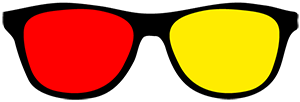Spectacles! Of A Different Color!

Introduction
Light in the electromagnetic spectrum is comprised of vibrations of electric and magnetic fields which travel as waves through space. Each electromagnetic wave has a specific frequency and wavelength associated with that frequency. Although the electromagnetic spectrum is very large, our eyes are capable of seeing only a very narrow part of it called the visible spectrum . As white light passes through small water droplets in the cloud, it is bent into the visible spectrum of red to violet commonly seen in a rainbow. Electromagnetic waves including microwaves, radio waves, X-rays, and gamma rays are not visible to human beings.
National Science Education Standards Addressed
- Abilities Necessary to DO SCIENTIFIC INQUIRY/UNDERSTANDING about SCIENTIFIC INQUIRY
- PROPERTIES of Objects and Materials/LIGHT, Heat, Electricity, and Magnetism
- Understanding about SCIENCE and TECHNOLOGY/SCIENCE as a HUMAN ENDEAVOR
Materials Needed
- Transparent plastic drinking cups (red, blue, yellow)
- balloons (red, blue, yellow)
- one sheet of copy paper
- television with remote control
- desk lamp with black light (in place of the incandescent bulb)
Investigation
Use the remote control to turn on the television to use light from the non-visible spectrum. Shine the black light on people and objects in your classroom to show how different the world appears in near-ultraviolet light. Blow up one balloon in each color until you can easily see through it but not burst it. Take one of each color of plastic drinking cup. Select five places outside the classroom with: 1) various trees like pine and oak, 2) houses with yards, 3) people or pets, 4) sky, clouds, land, and water, and 5) a place of your choice. View the sites through the balloons and describe what you see. View the sites through the plastic drinking cups and describe what you see.
Inquiry
- Which colors allowed you to see most normally? Which colors gave you the most distorted view? Whatis the difference between viewing the sites with the balloons and the cups? What accounts for the difference? Would using colored glass to observe the sites have yielded more information than the balloons? Why or why not? Would using colored glass to observe the sites have yielded more information than the plastic cups? Why or why not?
- If you were lost in the forest, what color lenses would you like to have in your glasses? Why? Which color would be least helpful to you? Why? How and when do these colors help us see better? What color lenses would you want in your glasses if you were attempting to see better at night? Why?
- What is remote sensing and how does it relate to the experiment? How is remote sensing used?
Activities
- Use clear cups with 50 ml of water and food coloring (red, blue, and yellow) to create the visiblespectrum. Place the cups on the piece of white copy paper. Mix the different colors two at a time to discover the colors in the visible spectrum. What color is made by mixing one drop of red with one drop of yellow? What color is made by mixing one drop of red with one drop of blue? What color is made by mixing one drop of blue with yellow? What color is made by mixing red and green? What color is made by mixing green and blue? What color is made by mixing red, blue and green? Report your findings to the class.
- Research remote sensing techniques and their applications in the military and industry using theinternet. Compile a bibliography of the information sites. Share your most interesting applications with the class. Compile a list of the web sites to share with the class.
- Design a directory to assist classmates in interpreting specific kinds of scenery using different color lenses for remote sensing purposes. Make a copy of the directory for each member of the class.
- Develop a color wheel showing the basic colors, complementary colors, and various color mixtures. Apply the results of the initial experiment to the colors on the color wheel. Draw or copy a blank picture form a coloring book. Color the pictures with only the primary colors, only the complementary colors and only the secondary colors. What similarities and differences do you see in the pictures? Which set of pictures most closely resemble pictures obtained using passive remote sensing?